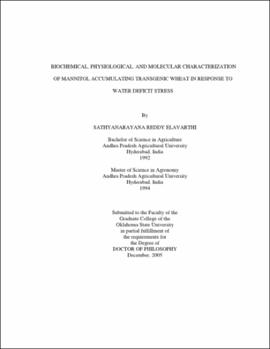| dc.contributor.advisor | Martin, Bjorn C. | |
| dc.contributor.author | Elavarthi, Sathyanarayana Reddy | |
| dc.date.accessioned | 2013-12-10T18:04:33Z | |
| dc.date.available | 2013-12-10T18:04:33Z | |
| dc.date.issued | 2005-12 | |
| dc.identifier.uri | https://hdl.handle.net/11244/7724 | |
| dc.description.abstract | Water deficit stress is a major factor that affects crop productivity. Mannitol accumulation has been reported to increase tolerance of plants to water deficit stress through several mechanisms. In this study we evaluate the effect of mannitol accumulation in transgenic wheat that has a bacterial mtlD (mannitol-1-phosphate dehydrogenase) gene causing mannitol biosynthesis in either cytosol or chloroplasts. The objectives were to study 1. the physiological effects of mannitol accumulation, 2. the role of mannitol in oxidative stress protection, and 3. to quantify the mtlD expression and copy number in the transgenic plants. Five transgenic events were used in this study, TA2-110, TA2-118 (mannitol biosynthesis in cytosol), TA5-104, TA5-108 (mannitol biosynthesis in chloroplasts), and pAHC20 (with selectable marker alone) along with the wild type (cv Bobwhite). Mannitol accumulation was observed in all the lines and the amount ranged from 0.10-0.40 �mol g-1 fwt. No difference in water relations were observed between the transgenic lines and the controls. The amount of mannitol is not great enough to make a significant contribution osmotically. Net photosynthesis rate was greater in the transgenic lines compared to controls as stress progressed but no difference in chlorophyll fluorescence (Fv/Fm) was observed. Leaf extracts from the transgenic lines showed greater capacity to scavenge hydroxyl radicals than the control in vitro. The transgenic lines also showed less lipid peroxidation compared to the controls as a result of stress. TA5 lines in which mannitol biosynthesis is targeted to chloroplast showed the lowest level of lipid peroxidation. Mannitol accumulation, even in small quantities imparts oxidative stress protection to the transgenic plants. Transgene expression varied among the different transgenic lines and increased under stress. TA2 lines showed greater expression than the TA5 lines. Transgene expression was absent in two treatments in the T4 generation. The absence of transgene expression may be due to transgene silencing. All the transgenic lines had multiple copies of the mtlD gene integrated into the genome. With eight copies TA2-110 had the least and with 14 copies TA5-104 had the most transgene copies per haploid genome. | |
| dc.format | application/pdf | |
| dc.language | en_US | |
| dc.rights | Copyright is held by the author who has granted the Oklahoma State University Library the non-exclusive right to share this material in its institutional repository. Contact Digital Library Services at lib-dls@okstate.edu or 405-744-9161 for the permission policy on the use, reproduction or distribution of this material. | |
| dc.title | Biochemical, physiological, and molecular characterization of mannitol accumulating transgenic wheat in response to water deficit stress | |
| dc.contributor.committeeMember | Guenzi, Arron C. | |
| dc.contributor.committeeMember | Anderson, Jeffrey A. | |
| dc.contributor.committeeMember | Mort, Andrew J. | |
| osu.filename | Elavarthi_okstate_0664D_1640 | |
| osu.accesstype | Open Access | |
| dc.type.genre | Dissertation | |
| dc.type.material | Text | |
| thesis.degree.discipline | Plant and Soil Sciences | |
| thesis.degree.grantor | Oklahoma State University | |
